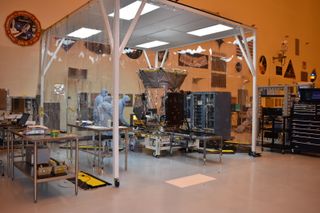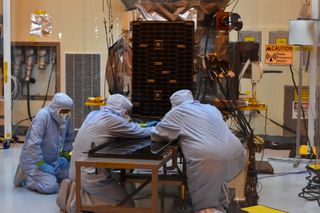Inside the Clean Room: NASA's Exoplanet-Hunter TESS Gets Prepped for Launch
CAPE CANAVERAL, Fla. — Final preparations are underway here at Kennedy Space Center to get NASA's next planet-hunting spacecraft, the Transiting Exoplanet Survey Satellite (TESS), ready for its planned April 16 launch.
The satellite, built by Orbital ATK, arrived here on Feb. 12 after a 17-hour drive down from Orbital's facility in Dulles, Virginia, and was ushered inside the Payload Hazardous Servicing Facility (PHSF) to be readied for launch.

However, before it hitches a ride to space atop SpaceX's Falcon 9 rocket, NASA invited members of the media to get a close-up look at TESS inside a specialized clean room. The PHSF is one of the last stops a spacecraft makes before launch. Inside this unique facility, engineers conduct final tests and load hazardous fuels, such as hydrazine that will help propel the spacecraft. Therefore, anyone who enters must follow a strict protocol, including wearing a special suit known as a bunny suit. [The Most Intriguing Alien Planet Discoveries of 2017]

Before entering the clean room, a group of eager journalists were regaled with mission specifics by the TESS team, which included the mission's principal investigator, George Ricker of MIT's Kavli Institute for Astrophysics and Space Research.
The TESS mission, which is managed by NASA's Goddard Space Flight Center in Greenbelt, Maryland, and operated by the Massachusetts Institute of Technology (MIT), will spend at least two years studying more than 200,000 of the closest and brightest stars in our solar neighborhood.
TESS will scan the sky, looking for tiny dips in starlight. These dips in brightness — known as transits — could indicate that one or more planets is orbiting the star. Ricker said that the team expects to discover several thousand planets during the spacecraft's mission. [7 Ways to Discover Alien Planets]
"This mission is one for the ages," Ricker said during the mission briefing.
Get the Space.com Newsletter
Breaking space news, the latest updates on rocket launches, skywatching events and more!
The Kepler Space Telescope, NASA's planet-hunting powerhouse, has identified more than 2,000 confirmed exoplanets using the same "transit" technique as TESS. However, TESS has a much larger field of view — nearly 20 times larger than Kepler — potentially allowing it to surpass Kepler in the number of exoplanet discoveries.
Thanks to Kepler, we now know that planets around other stars are very common. Kepler spent its primary mission staring at a narrow patch of sky to answer that very question. Unfortunately, all of Kepler's discoveries are too far away for follow-up study.
This is where TESS comes in. Since it will focus on nearby, bright stars, "TESS will identify the very best targets for future missions, like [NASA's upcoming] James Webb Space Telescope, to study in more detail," Ricker said.
Scheduled to launch next year, Webb will scan the targets identified by TESS to look for water vapor, methane and other atmospheric gases. And, with a little luck, Webb might even spot signatures indicative of life beyond Earth.

Following the science and safety briefings, and once the group was suited up, we stepped into the clean room and got our first look at the silvery spacecraft. Spanning roughly 60 inches (1.5 meters) in size, TESS is small, but extremely capable.
TESS will search for exoplanets as it performs an all-sky survey. The sky will be divided into 26 observational sectors per hemisphere of the sky, with TESS staring at each sector for 27 days.
"It goes beyond just exoplanets," Ricker told Space.com. "TESS's images will also enable a broad range of astrophysics discoveries."
In order to carry out the spacecraft's science objective, the team had to plan a unique orbit, which proved to be one of the biggest challenges of the mission.
TESS will launch into a high, elliptical orbit around Earth that is in a 2:1 resonance with the moon — it will orbit twice for every one time the moon goes all the way around. This type of orbit has multiple benefits: it is very stable, meaning it won’t be affected by space debris, radiation, while allowing the spacecraft to easily communicate with the ground.
However, this type of orbit limits the number of launch opportunities, as it must be synchronized with the moon's orbit around the Earth. After launch, it will take the spacecraft two months to reach its destination.

During our visit, engineers were prepping the spacecraft for final testing before launch. That testing included final checkouts of the solar arrays and is expected to be completed February 21. Next, TESS will be mated to the launch vehicle.
Originally slated to launch on March 20, TESS is currently scheduled to lift off on April 16, following a one-month delay requested by the launch provider, SpaceX. However, TESS must launch by June per congressional mandate.
Follow us @Spacedotcom, Facebook and Google+. Original article on Space.com.
Join our Space Forums to keep talking space on the latest missions, night sky and more! And if you have a news tip, correction or comment, let us know at: community@space.com.

Amy Thompson is a Florida-based space and science journalist, who joined Space.com as a contributing writer in 2015. She's passionate about all things space and is a huge science and science-fiction geek. Star Wars is her favorite fandom, with that sassy little droid, R2D2 being her favorite. She studied science at the University of Florida, earning a degree in microbiology. Her work has also been published in Newsweek, VICE, Smithsonian, and many more. Now she chases rockets, writing about launches, commercial space, space station science, and everything in between.
